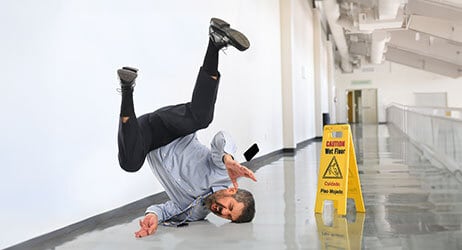Fall and slip incidents are a major global cause of unintentional injury and are a common cause for concern. These occurrences, which frequently affect elderly people and others with pre-existing medical issues, can range in severity from small annoyances to catastrophic tragedies. It is imperative to comprehend the fundamental reasons behind slip and fall injuries and put preventative measures in place to reduce their frequency and protect people’s health.
Typical Reasons for Slip and Fall Accidents
Accidents involving slips and falls are caused by a variety of variables, most frequently by a confluence of personal habits and environmental dangers. The following are a few of the most common causes:
- Hazardous Surfaces:
The chance of slipping and falling can be greatly increased by damp or oily flooring, uneven surfaces, loose carpets or matting, and slick paths.
- Weather:
Unfavorable weather conditions, such rain, snow, or ice, can make it dangerous to walk, especially on parking lots, walkways, and stairs.
- Incorrect Footwear:
Traction and stability might be jeopardized by wearing incorrect footwear, such as high heels, out-of-date soles, or footwear unfit for a certain terrain.
- Inadequate illumination:
Inadequate illumination, particularly in dimly lit locations or during transitions between bright and dark surroundings, can make it difficult to spot risks and move safely.
- Bad Housekeeping Practices:
Tripping risks such as spills, loose cords or wires, and cluttered hallways raise the risk of falls.
- Inattention and Obstacles:
Distractions like texting, talking on the phone, or carrying goods can draw attention away from possible risks, which increases the risk of falls and slips.
- Physical Factors:
An individual’s risk of falling might be increased by age, certain drugs, eyesight impairments, and balance concerns.
Managing Slip and Fall Hazards: Efficacious Techniques
An integrated strategy addressing environmental and individual factors is necessary to prevent slip and fall incidents. The following are some essential precautions:
-
Keep a Clean and Safe Environment: To avoid spills and debris, regularly clean and maintain floors. Make sure there are no loose cords, clutter, or slick surfaces in the walkways.
- Install Adequate illumination: Make sure that all spaces, such as stairwells, hallways, and outside walks, have enough illumination. Put up motion-activated lighting where there is low light.
- Use Slip-Resistant Flooring: Install flooring materials resistant to slippage in damp places, like kitchens, bathrooms, and entryways.
- Make Use of Warnings and Signage: Post warning signs in areas that could be dangerous, such damp floors or uneven surfaces.
- Promote Appropriate Footwear: Promote the use of appropriate, supportive, and traction-enhancing footwear. Steer clear of wearing shoes with worn-out soles or high heels.
- Encourage Safety Awareness: Spread knowledge on how to minimize falls and slips by stressing the value of being alert to your surroundings, putting down distractions, and using handrails when they are available.
- Regular Maintenance and Inspection: Look for potential risks on a regular basis when inspecting floors, stairs, handrails, and other walking surfaces. Replace or repair any worn-out or damaged parts as soon as possible.
- Address Individual Risk Factors: To ensure that the right actions are implemented, people with balance concerns, vision problems, or other risk factors should be encouraged to speak with healthcare specialists.
Safety and Legal Measures
It is essential to take the proper legal and safety precautions in the case of a slip and fall accident to protect oneself and guarantee accountability.
- Seek Quick Medical Attention:
In the event of an injury, get medical help right away to determine the extent of the damage and to begin the right course of therapy.
- Report the Incident:
Inform the employer or the owner of the property about the incident, including the location, reason for it, and any witnesses.
- Record the Incident:
Take pictures or videos of the incident, making note of any surfaces or dangerous conditions that may have contributed to the fall.
- Seek Legal Advice:
To find out if you have a strong case, speak with a knowledgeable personal injury lawyer.
- Adhere to Safety Regulations:
To prevent slip and fall accidents, employers are required by law to create a safe workplace and to follow safety guidelines.
- Encourage a Culture of Safety:
In the community or workplace, foster an attitude that prioritizes safety by encouraging candid discussion about safety-related issues.
By putting these preventive measures into practice and abiding by the law and safety regulations, we can greatly lower the number of slip and fall incidents and create a safer atmosphere for everybody.
Contact now at (718) 414-6642 for a free consultation about your situation.


 How Can You Safeguard Yourself Against Slip and Fall Accidents?
How Can You Safeguard Yourself Against Slip and Fall Accidents? 

